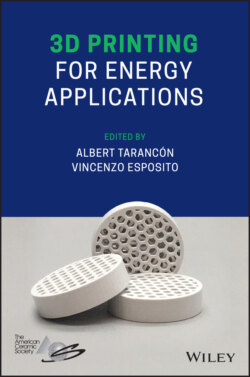Читать книгу 3D Printing for Energy Applications - Группа авторов - Страница 2
Table of Contents
Оглавление1 Cover
2 Title Page
3 Copyright Page
4 Contributors
5 Introduction to 3D Printing Technologies I.1 3D Printing Technologies I.2 3D Printing Hierarchical, Material and Functional Complexity I.3 3D Printing for Energy I.4 Scope of the Book References
6 Part I: 3D printing of functional materials 1 Additive Manufacturing of Functional Metals 1.1 Introduction 1.2 Powder Bed Fusion AM 1.3 Direct Material Deposition 1.4 Solid‐State Additive Manufacturing 1.5 Hybrid AM Through Green Body Sintering 1.6 Conclusions Acknowledgment References 2 Additive Manufacturing of Functional Ceramics 2.1 Introduction 2.2 Ceramics 3D Printing Technologies References 3 3D Printing of Functional Composites with Strain Sensing and Self‐Heating Capabilities 3.1 Introduction 3.2 Carbon Nanotube Reinforced Functional Polymer Nanocomposites 3.3 Printing Strategies 3.4 Strain Sensing of Printed Nanocomposites 3.5 Electric Heating Performance Analysis 3.6 Electrical Actuation of the CNT/SMP Nanocomposites 3.7 Conclusions References
7 Part II: 3D printing challenges for production of complex objects 4 Computational Design of Complex 3D Printed Objects 4.1 Introduction 4.2 Dedicated Computational Design for 3D Printing 4.3 Case Study: Computational Design of a 3D‐Printed Flow Manifold 4.4 Current State and Future Challenges References 5 Multicomponent and Multimaterials Printing 5.1 Multicomponent Printing: A Short Review 5.2 Multicomponent Printing: A Case Study on Piezoceramic Sensors in Smart Pipes 5.3 Summary and Outlook Acknowledgments References 6 Tailoring of AM Component Properties via Laser Powder Bed Fusion 6.1 Introduction 6.2 Machines, Materials, and Sample Preparation 6.3 Sample Preparation and Characterization Techniques 6.4 Material Qualification and Process Development 6.5 Tailoring Grain Size via Adaptive Processing Strategies 6.6 Tailoring Material Properties By Using Powder Blends 6.7 Tailoring Properties By Using Special Geometries Such As Lattice Structures Funding Conflicts of Interest References 7 3D Printing Challenges and New Concepts for Production of Complex Objects 7.1 Introduction 7.2 Geometrical Complexity 7.3 Material Complexity 7.4 Energy Requirements 7.5 Promising Metal Deposition Approaches 7.6 Multimaterial and Multi‐property SLA 7.7 Temporal Multiplexing 7.8 Resin Formulations with Multiple End‐States 7.9 Associated Processing Considerations 7.10 Bioprinting of Realistic and Vascularized Tissue 7.11 Emerging Volumetric Additive Processes 7.12 Computation for CAL 7.13 Material–Process Interactions in CAL 7.14 Current Challenges in CAL 7.15 Expanding the Capabilities of CAL 7.16 Concluding Remarks and Outlook Acknowledgments References
8 Part III: 3D printing of energy devices 8 Current State of 3D Printing Technologies and Materials 8.1 3D Printing of Energy Devices References 9 Capacitors 9.1 Introduction 9.2 Capacitors and Their Current Manufacture 9.3 The Promise of Additive Manufacturing 9.4 Additive Manufacturing Technologies: Considerations for Capacitor Fabrication 9.5 Summary and Outlook References 10 3D‐Printing for Solar Cells 10.1 Introduction 10.2 Examples of 3D‐Printing for PV 10.3 Geometric Light Management 10.4 Conclusions References 11 3D Printing of Fuel Cells and Electrolyzers 11.1 Introduction 11.2 3D Printing of Solid Oxide Cells Technology 11.3 3D Printing of Polymer Exchange Membranes Cells Technology 11.4 3D Printing of Bio‐Fuel Cells Technology 11.5 Conclusions and Outlook References 12 DED for Repair and Manufacture of Turbomachinery Components 12.1 Introduction 12.2 DED Based Repair of Turbomachinery Components 12.3 DED Based Hybrid Manufacturing of New Components 12.4 Summary Acknowledgments References 13 Thermoelectrics 13.1 Introduction 13.2 Additive Manufacturing Techniques of Thermoelectric Materials Acknowledgements References 14 Carbon Capture, Usage, and Storage 14.1 Introduction 14.2 Can 3D Printing Be Used to Fabricate a CO2 Capture Process at Scale? 14.3 A Brief Note on 3D Printing and CO2 at Smaller Scales & Research Efforts 14.4 Conclusions References
9 Index
10 End User License Agreement
